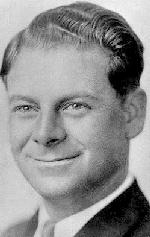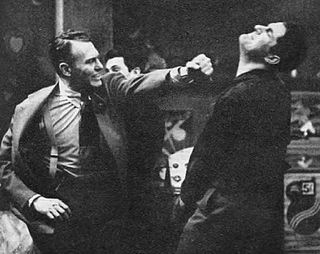Related Research Articles
The year 1957 in television involved some significant events. Below is a list of television-related events during 1957.
The year 1951 in television involved some significant events. Below is a list of television-related events during 1951.

The First Hundred Years was the first ongoing TV soap opera in the United States that began as a daytime serial, airing on CBS from December 4, 1950 until June 27, 1952.

The Garry Moore Show is the name for several separate American variety series on the CBS television network in the 1950s and 1960s. Hosted by experienced radio performer Garry Moore, the series helped launch the careers of many comedic talents, such as Dorothy Loudon, Don Adams, George Gobel, Carol Burnett, Don Knotts, Lee Goodman, James Kirkwood, Jr., Lily Tomlin, and Jonathan Winters. The Garry Moore Show garnered a number of Emmy nominations and wins.
The 1955–56 network television schedule for the four major English language commercial broadcast networks in the United States. The schedule covers primetime hours from September 1955 through March 1956. The schedule is followed by a list per network of returning series, new series, and series cancelled after the 1954–55 season.

Albert Pearce was an American comedian, singer and banjo player who was a popular personality on several radio networks from 1928 to 1947.
The following is the 1956–57 network television schedule for the three major English language commercial broadcast networks in the United States. The schedule covers primetime hours from September 1956 through March 1957. The schedule is followed by a list per network of returning series, new series, and series cancelled after the 1955–56 season.
The following is the 1951–52 network television schedule for the four major English language commercial broadcast networks in the United States. The schedule covers primetime hours from September 1951 through March 1952. The schedule is followed by a list per network of returning series, new series, and series cancelled after the 1950–51 season. This was the first television season of national network interconnection by coaxial cable and microwave, meaning programming could be transmitted live coast-to-coast if needed.
The following is the 1952–53 network television schedule for the four major English language commercial broadcast networks in the United States. The schedule covers primetime hours from September 1952 through March 1953. The schedule is followed by a list per network of returning series, new series, and series cancelled after the 1951–52 season.

The Paramount Television Network, Inc. was a venture by American film corporation Paramount Pictures to organize a television network in the late 1940s. The company-built television stations KTLA in Los Angeles and WBKB in Chicago; it also invested $400,000 in the DuMont Television Network, which operated stations WABD in New York City, WTTG in Washington, D.C., and WDTV in Pittsburgh. Escalating disputes between Paramount and DuMont concerning breaches of contract, company control, and network competition erupted regularly between 1940 and 1956, culminating in the DuMont Network's dismantling. Television historian Timothy White called the clash between the two companies "one of the most unfortunate and dramatic episodes in the early history of the television industry."

Hotel de Paree is a Western television series starring Earl Holliman that aired thirty-three episodes on the CBS Friday evening from October 2, 1959, until September 23, 1960, under the alternate sponsorship of the Liggett & Myers company and Kellogg's.

Man Against Crime starring Ralph Bellamy, one of the first television programs about private eyes, ran on CBS, the DuMont Television Network and NBC from October 7, 1949, to June 27, 1954, and was briefly revived, starring Frank Lovejoy, during 1956. The show was created by Lawrence Klee and was broadcast live until 1952. The series was one of the few television programs ever to have been simulcast on more than one network: the program aired on both NBC and DuMont during the 1953–54 television season.
Doc Corkle is an American sitcom that was broadcast on NBC Television from October 5 through October 19, 1952. The show was cancelled after 3 episodes and replaced by Mister Peepers. Insufficient ratings were reported to be the cause of the switch.
Steve Randall is an American detective television series starring Melvyn Douglas. The series' 13 episodes were initially seen in syndication during the summer of 1952, before being picked up and rerun by the DuMont Television Network from November 7, 1952, to January 30, 1953. CBS subsequently ran 9 of the same 13 episodes again from June 16, 1953, to August 11, 1953.
Starlight Theatre is a 30-minute American television anthology series of romantic stories that aired on CBS from April 2, 1950, to October 4, 1951. Forty-nine episodes aired. In 1950-1951 it alternated with The George Burns and Gracie Allen Show.

The Bill Goodwin Show is a variety program that was broadcast on NBC television from September 11, 1951 to March 27, 1952.

Claudia is an American television program that was broadcast live on NBC January 6, 1952 - March 23, 1952 and on CBS March 31, 1952 - June 30, 1952. The situation comedy was based on Rose Franken's short stories and novels about a young woman's romance.
Hollywood Opening Night is an American anthology television program that was broadcast on CBS in 1951-1952 and on NBC in 1952-1953. The NBC version was the first dramatic anthology presented live from the West Coast. Episodes were 30 minutes long.
Leave It to Larry is an American television situation comedy that was broadcast on CBS from October 14, 1952, until December 23, 1952, for a total of 11 episodes.
My Friend Irma is an American comedy television series that was broadcast on CBS from January 8, 1952, until June 25, 1954.
References
- ↑ Terrace, Vincent (2009). Encyclopedia of Television Shows, 1925 through 2007 (Volume 1 A-E). Jefferson, North Carolina: McFarland & Company, Inc. ISBN 978-0-7864-3305-6.
- ↑ Hyatt, Wesley (2003). Short-Lived Television Series, 1948-1978: Thirty Years of More Than 1,000 Flops. McFarland. p. 39. ISBN 9780786414208 . Retrieved 22 September 2016.
- ↑ "CBS's Pearce Seg Goes Live". Billboard. March 1, 1952. p. 7. Retrieved 22 September 2016.
- ↑ "Last Week's Network Changes". Ross Reports on Television including The Television Index. September 21, 1952. p. 2. Retrieved May 14, 2022.
- ↑ McNeil, Alex (1996). Total Television (4th ed.). New York, New York: Penguin Books USA, Inc. p. 21. ISBN 0-14-02-4916-8.
- ↑ "Al Pearce". Tralfaz: Cartoons & Tralfazian Stuff. 2012-10-03. Retrieved 2016-08-14.
- ↑ "The Al Pearce Show". ClassicThemes.com. Retrieved 2016-08-27.